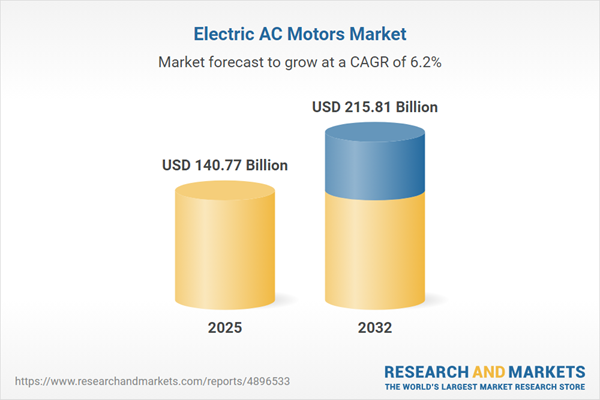Speak directly to the analyst to clarify any post sales queries you may have.
The electric AC motors market is experiencing significant transformation as industries prioritize energy efficiency, digital integration, and supply chain resilience. Senior decision-makers are navigating a shifting landscape shaped by advancing technologies, evolving regulations, and new strategic imperatives.
Electric AC Motors Market Snapshot
The electric AC motors market grew from USD 133.04 billion in 2024 to USD 140.77 billion in 2025 and is projected to maintain momentum at a CAGR of 6.23%, reaching USD 215.81 billion by 2032. This sustained growth is fueled by rapid technological advancements, regulatory pressures favoring energy-efficient solutions, and the expansion of advanced industrial automation and electrified mobility across key regions.
Scope & Segmentation of the Electric AC Motors Market
- Motor Types: Asynchronous motors including single-phase induction motors and three-phase induction motors, synchronous motors, and niche motors for precision tasks and efficiency optimization.
- Output Power: Below 0.5 HP for small and consumer applications, 0.5 HP to 10 HP supporting manufacturing and fluid handling, and greater than 10 HP for heavy-duty, continuous operations.
- Voltage Class: Less than 1,000 V addressing general uses, 1,000 V-6,600 V for industrial needs, and above 6,600 V for large-scale power solutions.
- Control Type: Automatic control with advanced drives and communication protocols, and manual control for cost-driven or simple applications.
- Phase: Single-phase and three-phase AC motors meeting diverse industrial and residential demands.
- Speed Control: Fixed speed and variable speed motors enabling both standardized and highly adaptable operations.
- Applications: Compressors, conveyor systems, cranes & hoists, electric vehicles, fans, mixers, agitators, and pumps driving growth across manufacturing and mobility segments.
- Distribution Channels: Offline routes, online sales through company websites and eCommerce platforms, reflecting changing procurement preferences.
- End-Use Industries: Automotive, construction, energy & power, food & beverage, healthcare, manufacturing, mining, and oil & gas aligning sector-specific performance needs.
- Regional Segmentation: Coverage includes Americas (with sub-regions in North and Latin America), Europe, Middle East & Africa, and Asia-Pacific, capturing diverse regulatory and economic dynamics.
Key Takeaways for Senior Decision-Makers
- Heightened regulatory requirements and digital transformation trends are shifting market focus toward high-efficiency designs and software-enabled maintenance solutions.
- Advanced sensor integration and material innovation are enabling real-time monitoring, predictive maintenance, and lifecycle optimization of motor assets.
- Strategic partnerships between manufacturers, technology firms, and research entities are driving collaborative innovation and differentiated value propositions.
- Regional supply chain strategies, including reshoring and nearshoring, are gaining traction as companies seek to navigate new trade landscapes and build operational resilience.
- Distribution models are evolving, with a growing emphasis on direct and digital channels to meet end-user demand for transparent, seamless procurement experiences.
Impact of US Trade Tariffs on Structure and Pricing
The 2025 introduction of trade tariffs in the US has altered sourcing strategies and increased operational complexity for electric AC motor manufacturers. These measures have led to a reassessment of supplier networks and have encouraged the establishment of regional production hubs. As affected suppliers realign capacities, the competitive environment outside North America sees increased activity, particularly in Asia-Pacific and Europe, where favorable policies and sustained infrastructure investments attract global expansion strategies.
Methodology & Data Sources
This report employs a multi-faceted research methodology grounded in comprehensive secondary research, in-depth interviews with industry leaders, and quantitative analysis of market data. Validation through primary interviews with executives and engineers across global regions ensures accuracy and current relevance. Analytical techniques such as SWOT and scenario modeling further enrich the market perspective.
Why This Report Matters: Actionable Insights for Electric AC Motors
- Enables C-suite decision-makers to benchmark technology investments and supply chain strategies against evolving regulatory and market trends.
- Highlights opportunities for product and service differentiation through digitalization, advanced materials, and lifecycle management.
Conclusion
Innovation, supply chain adaptation, and digital transformation are redefining the electric AC motors industry. This detailed analysis empowers senior leaders to anticipate shifts, align strategies, and capture new growth opportunities in an increasingly complex marketplace.
Additional Product Information:
- Purchase of this report includes 1 year online access with quarterly updates.
- This report can be updated on request. Please contact our Customer Experience team using the Ask a Question widget on our website.
Table of Contents
3. Executive Summary
4. Market Overview
7. Cumulative Impact of Artificial Intelligence 2025
Companies Mentioned
The companies profiled in this Electric AC Motors market report include:- ABB Ltd.
- Allient Inc.
- Ametek Inc.
- BorgWarner Inc.
- Danfoss A/S
- DENSO Corporation
- Emerson Electric Co.
- Farmtech Industries
- General Electric Company
- Groschopp AG
- Hitachi Ltd.
- Hiwin Corporation
- Johnson Electric Holdings Ltd.
- Kirloskar Electric Company
- Mitsubishi Electric Corporation
- Nidec Motor Corporation
- OMEGA Engineering inc.
- Regal Rexnord Corporation
- Renesas Electronics Corporation
- Robert Bosch GmbH
- Rockwell Automation Inc.
- Schneider Electric SE
- SEW-EURODRIVE GmbH & Co KG
- Siemens AG
- Sinotech
- Toyota Material Handling, Inc.
- Wolong Electric Group
- ZF Friedrichshafen AG
Table Information
| Report Attribute | Details |
|---|---|
| No. of Pages | 191 |
| Published | November 2025 |
| Forecast Period | 2025 - 2032 |
| Estimated Market Value ( USD | $ 140.77 Billion |
| Forecasted Market Value ( USD | $ 215.81 Billion |
| Compound Annual Growth Rate | 6.2% |
| Regions Covered | Global |
| No. of Companies Mentioned | 29 |









